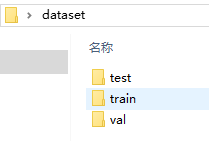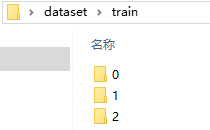1、定义各种参数
下面举例三种常见的参数
batch_size = 8
learning_rate = 1e-4
epoches = 100
2、利用官方的数据加载
指定训练、验证以及测试的文件夹的路径,其下一个目录的各个文件夹视为各个类别。下一个目录为了方便简单可以直接命名为0、1、2等。到时就可以对应0、1、2等类别。也可以按本身类别作为文件名,可能需要调试注意一下对应的类别0、1、2等。如:


0、1、2文件夹里放置对应类别的图像即可。主要调用的是torchvision.datasets.ImageFolder和torch.utils.data.DataLoader。
import torchvision.datasets as dsets
import torchvision.transforms as transforms
trainpath = './dataset/train/'
valpath = './dataset/val/'
traintransform = transforms.Compose([
transforms.RandomRotation(20), # optional
transforms.ColorJitter(brightness=0.1),
transforms.Resize([224, 224]),
transforms.ToTensor(), # 将图片数据变为tensor格式
# transforms.Normalize(mean=[0.485, 0.456, 0.406],
# std=[0.229, 0.224, 0.225]),
])
valtransform = transforms.Compose([
transforms.Resize([224, 224]),
transforms.ToTensor(), # 将图片数据变为tensor格式
])
trainData = dsets.ImageFolder(trainpath, transform=traintransform) # 读取训练集,标签就是train目录下的文件夹的名字,图像保存在格子标签下的文件夹里
valData = dsets.ImageFolder(valpath, transform=valtransform)
trainLoader = torch.utils.data.DataLoader(dataset=trainData, batch_size=batch_size, shuffle=True)
valLoader = torch.utils.data.DataLoader(dataset=valData, batch_size=batch_size, shuffle=False)
这里顺便提一下获取train或者test的总数量。
test_sum = sum([len(x) for _, _, x in os.walk(os.path.dirname(path_test))])
train_sum = sum([len(x) for _, _, x in os.walk(os.path.dirname(path_train))])
3、定义模型
这里,以调用最简单的torchvision自带的resnet34为例。
import torchvision.models as models
model = models.resnet34(pretrained=True) #pretrained表示是否加载已经与训练好的参数
model.fc = torch.nn.Linear(512, 3) #将最后的fc层的输出改为标签数量(如3),512取决于原始网络fc层的输入通道
model = model.cuda() # 如果有GPU,而且确认使用则保留;如果没有GPU,请删除
""" 可以用以下的例子试一下效果
import torchvision
import torch
model = torchvision.models.resnet34(pretrained=False)
model.fc = torch.nn.Linear(512, 3)
print(model)
input = torch.randn(4,3,224,224)
output = model(input)
print(output.size()) # torch.Size([4, 3])
"""
当然,可以将源码对应的resnet结构全部提取出来,进行改进。
4、定义损失函数以及优化器
criterion = torch.nn.CrossEntropyLoss() # 定义损失函数
optimizer = torch.optim.Adam(model.parameters(), lr=learning_rate)
# optimizer = torch.optim.SGD(model.parameters(), lr=learning_rate) # 定义优化器
5、train()函数
train函数里,每一个batch的数据训练过程一般包括:将梯度置为0(optimizer.zero_grad())、将图像传入网络(model(input))、调用损失函数(criterion(target, label))、将loss进行反传(loss.backward())、通过梯度下降执行参数更新(optimizer.step())以及其他你需要统计的东西。
from torch.autograd import Variable
def train(model, optimizer, criterion):
model.train()
total_loss = 0
train_corrects = 0
for i, (image, label) in enumerate(trainLoader):
image = Variable(image.cuda()) # 同理
label = Variable(label.cuda()) # 同理
optimizer.zero_grad()
target = model(image)
loss = criterion(target, label)
loss.backward()
optimizer.step()
total_loss += loss.item()
max_value, max_index = torch.max(target, 1)
pred_label = max_index.cpu().numpy()
true_label = label.cpu().numpy()
train_corrects += np.sum(pred_label == true_label)
return total_loss / float(len(trainLoader)), train_corrects / train_sum
6、evaluate()函数
与train()函数的区别在于,不需要更新梯度,因此没有梯度置0以及loss反转的过程以及优化器更新。此外,验证过程,需要将图像送入网络,计算loss。
def evaluate(model, criterion):
model.eval()
corrects = eval_loss = 0
with torch.no_grad():
for image, label in testLoader:
image = Variable(image.cuda()) # 如果不使用GPU,删除.cuda()
label = Variable(label.cuda()) # 同理
pred = model(image)
loss = criterion(pred, label)
eval_loss += loss.item()
max_value, max_index = torch.max(pred, 1)
pred_label = max_index.cpu().numpy()
true_label = label.cpu().numpy()
corrects += np.sum(pred_label == true_label)
return eval_loss / float(len(testLoader)), corrects, corrects / test_sum
7、main()主函数
除了前面讲过的部分,这里主要列举多个epoch依次训练的步骤
import time
def main():
train_loss = []
valid_loss = []
accuracy = []
for epoch in range(1, epoches + 1):
epoch_start_time = time.time()
loss, train_acc = train(model, optimizer, criterion)
train_loss.append(loss)
print('| start of epoch {:3d} | time: {:2.2f}s | train_loss {:5.6f} | train_acc {}'.format(epoch, time.time() - epoch_start_time, loss, train_acc))
loss, corrects, acc = evaluate(model, criterion)
valid_loss.append(loss)
accuracy.append(acc)
if acc > bestacc:
torch.save(model, save_model_path + 'bestmodel.pth')
bestacc = acc
print('| end of epoch {:3d} | time: {:2.2f}s | test_loss {:.6f} | accuracy {}'.format(epoch, time.time() - epoch_start_time, loss, acc))
print("**********ending*********")
plt.plot(train_loss)
plt.plot(valid_loss)
plt.title('loss')
plt.ylabel('loss')
plt.xlabel('epoch')
plt.legend(['train', 'test'], loc='upper left')
plt.savefig("./loss.jpg")
# plt.show()
plt.cla()
plt.plot(accuracy)
plt.title('acc')
plt.ylabel('acc')
plt.xlabel('epoch')
plt.savefig("./acc.jpg")
# plt.show()
8、predict函數
预测函数可以得到对应的label以及预测的概率。
def predict():
model = torch.load(best_model_path)
model = model.cuda()
# model = models.resnet34()
# model.load_state_dict(torch.load(best_model_path, map_location=lambda storage, loc: storage), strict=True) # 利用cpu进行测试
model.eval()
testLoader = torch.utils.data.DataLoader(dataset=testData, batch_size=1, shuffle=False)
for i, (image, label) in enumerate(testLoader):
image = Variable(image.cuda()) # 如果不使用GPU,删除.cuda()
# image = Variable(image)
pred = model(image)
max_value, max_index = torch.max(pred, 1)
pred_label = max_index.cpu().numpy()
print(max_value, pred_label)
"""
probs = F.softmax(pred, dim=1)
# print("Sample probabilities: ", probs[:2].data.detach().cpu().numpy())
a, b = np.unravel_index(probs[:2].data.detach().cpu().numpy().argmax(),
probs[:2].data.detach().cpu().numpy().shape) # 索引最大值的位置 ###b就说预测的label
print(testLoader.dataset.imgs[i][0])
print('预测结果的概率:', round(probs[:2].data.detach().cpu().numpy()[0][b] * 100))
print("label: "+str(b))
"""